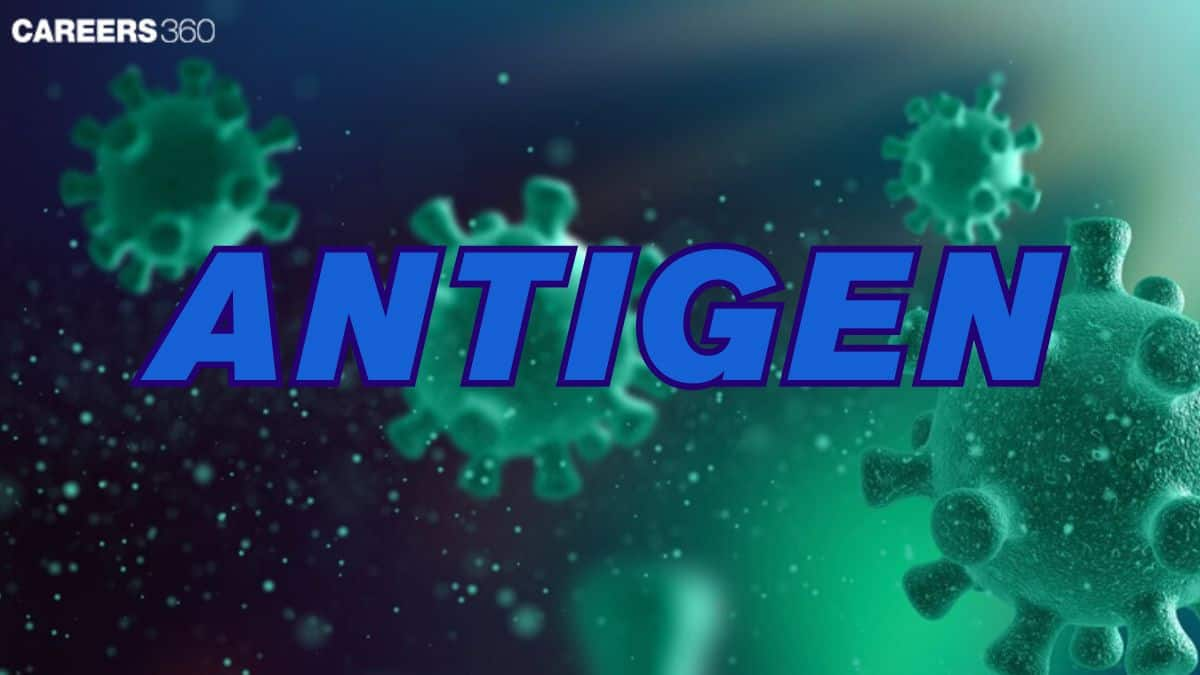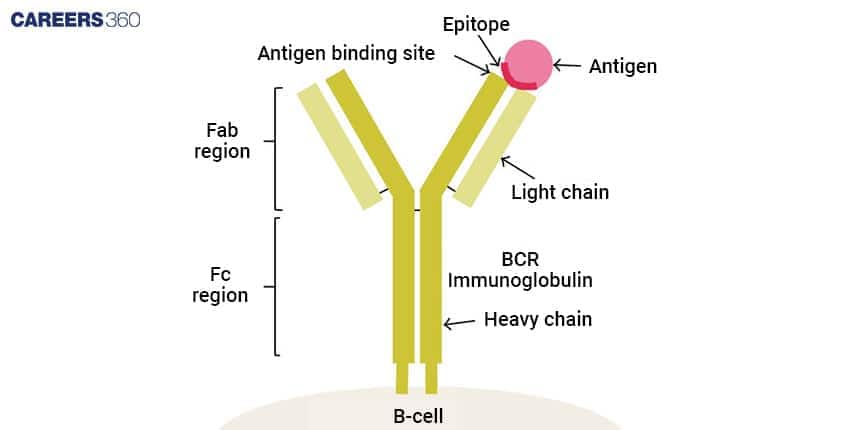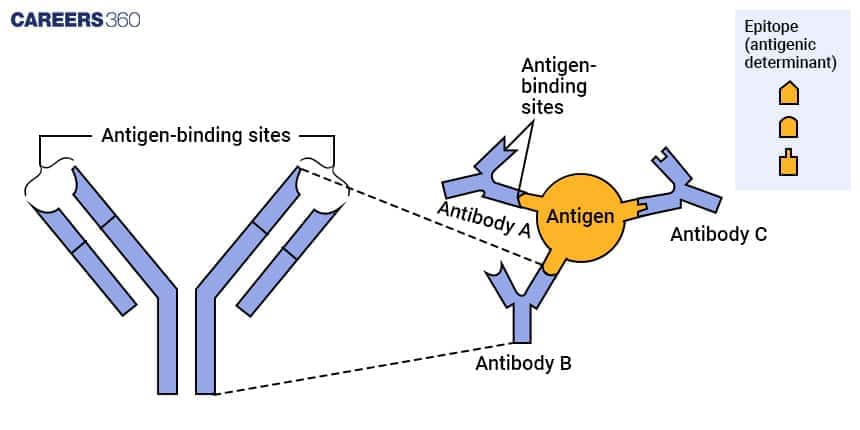Antigen and Immunology: Definition, Properties, Types, Structure, Function
An antigen is any foreign substance that triggers an immune response in the body, especially the production of antibodies. Antigens are usually proteins or polysaccharides found on the surface of pathogens like bacteria, viruses, and fungi. When the immune system detects these antigens, it activates specific defense mechanisms to fight the infection. Understanding antigens is essential in the study of immunology and how the immune system distinguishes between self and non-self.
This Story also Contains
- What is an Antigen?
- Antigen Structure
- Properties of Antigen
- Types of Antigen Based on Origin
- Types of Antigen Based on Immune Response
- How Antigens Work
- Functions of Antigens
- Antigens and the Immune System
- Tips, Tricks, and Strategies for Antigens and Immunology
- MCQs for Antigens and Immunology
- Frequently Asked Questions (FAQs)
- Recommended Video on Antigen

Antigens play a central role in various biological processes, including vaccination, antigen-antibody reactions, and the working of adaptive immunity. They are also involved in conditions like allergies and autoimmunity, where the immune response can become abnormal. Knowledge of antigens also supports the development of biotechnology-based treatments and preventive strategies.
What is an Antigen?
An antigen is any substance that triggers an immune response by binding to specific antibodies or immune cells. Antigens are foreign molecules like proteins or polysaccharides on pathogens (such as bacteria and viruses), but they can also include non-infectious substances like pollen or toxins. Some important antigen notes are discussed below:
Antigens are recognised and bound by an antibody or immune cell receptor which is called epitome.
Vaccines contain antigens from pathogens which helps the immune system to recognise and remember the pathogen.
Antigens also stimulate the production of antibodies by B cells and activate the T-cells.
They play a very crucial role in the entire immune system.
Antigen Structure
The structure of antigens varies depending on their origin, but most antigens are large biomolecules, such as proteins, polysaccharides, lipids, or nucleic acids. Epitopes, also known as antigenic determinants, are antigen components. Every antigen contains several epitopes.
Molecular Structure
Normally, antigens are proteins, polysaccharides, lipids, or nucleic acids. Their complex molecular architecture allows them to be recognised as non-self.
Epitope Explanation
An epitope, otherwise known as an antigenic determinant, is the portion of an antigen that binds to a particular antibody. An antigen possesses more than one epitope, which presents a diversified type of immune response.
The diagram below shows the structure of antigen

Properties of Antigen
Antigens are usually large, complex molecules that can trigger an immune response. They are mostly proteins or polysaccharides and are recognized as foreign by the immune system. They are so important because they help our immune system be prepared against invaders.
Property | Description |
Immunogenicity | The property of an antigen by which it can stimulate an immune response. |
Antigenicity | The ability of an antigen to combine specifically with the products of the immune response (for example, antibodies or T-cell receptors). |
Molecular Size | Larger molecules are, in general, more immunogenic than smaller ones. |
Complexity | More complex molecules, such as proteins, are more likely to be antigenic than simpler ones. |
Degradability | The immunogenicity of an antigen reflects its capacity to be processed by the immune system and affects how well it can be presented to the immune cells. |
Types of Antigen Based on Origin
Antigens have diverse types, depending on their sources, and each has very unique characteristics. The different types of antigen are discussed below:
Type of Antigens | Characteristics | Examples |
Exogenous Antigens | These antigens enter the body from external sources. | Pollen grains, dust mites and flu virus. |
Endogenous Antigens | Antigens are produced within the body's cells and result in infection or cellular damage. | Viral protein on the infected cells, the abnormal protein on the cancer cell. |
Autoantigens | Normal cellular proteins that the immune system mistakenly recognises as foreign agents. | Insulin Type 1, thyroid and thyroid receptors. |
Neoantigens | Newly formed antigens due to genetic mutations. These are generally related to cancer. | Tumour specific antigens. |
Types of Antigen Based on Immune Response
Antigens possess this unique quality of triggering an immune response, so they initiate the production of antibodies, which protect our body from harmful invaders. Depending on the type of immune response elicited, there are different categories of antigens.
Complete Antigen: They are also known as immunogens. It can induce an immune response. These antigens can be found in pathogen-associated molecules, such as the proteins in bacteria or viruses.
Incomplete Antigens: They are also known as haptens. The antigens are too small to carry an immune response by themselves and need to be conjugated with a carrier protein to be able to carry an immune response.
How Antigens Work
The interaction of antigens with the immune system is explained below:
Mechanism | Explanation |
Interaction with the Immune System |
|
Role in Triggering Immune Responses |
|
Antigen-Antibody Interaction |
|
Diagram of Antigen and Antibody
The diagram below shows the structure of antigen and antibody and their mechanism of action

Functions of Antigens
Some Important function of antigens is discussed below:
The antigen is important in the induction of both innate and adaptive immune responses, protecting the host from infection.
Vaccines use inactivated or weakened antigens to stimulate the immune system with the help of immunity, not causing disease.
At times, antigens cause hypersensitivity reactions, such as allergies and autoimmune diseases, wherein the immune system reacts too much.
Applications of Antigens in the Treatment of Diseases
Antigens find wide application in research labs in studies of the immune response and construction of new treatments. Some of them are discussed below:
Antigens find application/purpose in diagnostic tests such as the ELISA test to check for the presence of antibodies against a given sample.
Antigen-based therapies include vaccines and monoclonal antibodies for the treatment of infections and cancer.
The ELISA test detects specific antigens or antibodies in a sample; it is the assay widely used for diagnosing diseases like HIV and COVID-19.
Antigens and the Immune System
Role in Innate Immunity: It is just in innate immunity that antigens are seen as a result of this recognition by PRRs on the surface of immune cells, and an immediate but non-specific response is induced.
Role in Adaptive Immunity: Adaptive immunity is the specific recognition of antigens by B-cells and T-cells, which results in a targeted and long-lasting immune response.
Tips, Tricks, and Strategies for Antigens and Immunology
It takes effort to remember everything in a single go. We made the entire problem easy. Some of the tricks regarding Antigen and Immunology are given below which you can use to memorise the important points.
Types of Antigens Based on Origin
"ENA-N: Exogenous, Endogenous, Autoantigens, Neoantigens"
E: Exogenous
N: Endogenous
A: Autoantigens
N: Neoantigens
Immune System Cells
"BNT-M: B cells, Natural Killer cells, T cells, Macrophages"
B: B cells (produce antibodies to neutralize pathogens)
N: Natural Killer cells (kill virus-infected and cancer cells)
T: T cells (help regulate immune response or kill infected cells)
M: Macrophages (engulf and digest pathogens and dead cells)
Types of Immunity
"AA-NP: Active, Passive, Natural, Artificial"
A: Active immunity
A: Artificial immunity
N: Natural immunity
P: Passive immunity
Classes of Antibodies
"GAMED: IgG, IgA, IgM, IgE, IgD"
G: IgG (most common, provides long-term immunity)
A: IgA (found in mucous membranes, protects body surfaces)
M: IgM (first antibody produced during an immune response)
E: IgE (involved in allergic reactions)
D: IgD (role in B cell activation)
MCQs for Antigens and Immunology
Q1. Any substance or molecule that interacts with antibodies is called
Antigen
Immunogen
Hapten
None of these
Correct answer: 1) Antigen
Explanation:
An antigen is defined as an organism, a molecule, or part of a molecule or substance that may be self or non-self, can evoke a noticeable immune response, and can bind distinctively with antibodies.
Hence, the correct answer is an option 1) Antigen.
Q2. Assertion: Antigens are molecules that can stimulate an immune response in the body.
Reasoning: Antigens are recognized by the immune system as foreign, and can stimulate the production of antibodies or activate immune cells to attack the antigen.
Both Assertion (A) and Reason (R) are the true and Reason (R) is a correct explanation of Assertion (A).
Both Assertion (A) and Reason (R) are the true but Reason (R) is not a correct explanation of Assertion (A).
Assertion (A) is true and Reason (R) is false.
Assertion (A) is false and Reason (R) is true.
Correct answer: 1) Both Assertion (A) and Reason (R) are the true and Reason (R) is a correct explanation of Assertion (A).
Explanation:
Antigens are molecules that are recognized by the immune system as foreign or non-self. These molecules can come from a wide range of sources, including pathogens such as bacteria and viruses, as well as cancer cells and even transplanted tissues. When an antigen enters the body, it can be recognized by specialized cells of the immune system, called antigen-presenting cells (APCs), which display the antigen on their surface to alert other immune cells.
In response to the antigen, the immune system can produce antibodies, which are specialized proteins that can recognize and bind to the antigen. Antibodies can neutralize the antigen by preventing it from infecting cells or can mark it for destruction by other immune cells. In addition to antibodies, antigens can also activate immune cells such as T cells and B cells, which can directly attack the antigen and the cells that harbor it.
It's important to note that not all molecules can act as antigens. To stimulate an immune response, an antigen must be recognized as foreign by the immune system, which requires the presence of certain structures or features that are not present in the body's molecules. These structures, called epitopes, can be recognized by antibodies and immune cells, and are often found on the surface of pathogens.
Hence, the correct answer is option 1) Both Assertion (A) and Reason (R) are the true and Reason (R) is a correct explanation of Assertion (A).
Also Read:
Frequently Asked Questions (FAQs)
Q1. What are antigens?
Antigens are foreign substances, usually proteins, that trigger an immune response and lead to the production of antibodies.
Q2. What are three examples of antigens?
Examples of antigens include bacteria, viruses, and pollen.
Q3. Which blood has antigens?
All blood types have antigens; for example, type A has A antigen, type B has B antigen, and AB has both.
Q4. Are antigens living or dead?
Antigens can be from both living (like bacteria) or non-living (like toxins or vaccines) sources.
Q5. What are natural killers?
Natural killer (NK) cells are immune cells that destroy virus-infected and cancerous cells without needing specific antigens.
Recommended Video on Antigen
Frequently Asked Questions (FAQs)
Antigens are molecules that can trigger an immune response, which is important for the body to recognize pathogens and initiate defence.
Those antigens that are formed within the body are endogenous antigens. In contrast, those antigens that enter the body from the external environment through infection or some other means are called exogenous antigens.
Autoantigens are normally body proteins that are mistakenly identified by the immune system, which identifies them as if they were foreign antigens, thus leading to the production of any autoimmune response.
Antigens present in the vaccines trigger an immune response in the host, whereby the host produces antibodies to the disease and develops immunity to that particular disease.
RhD is the most significant Rh antigen. when RhD is visible on the surface of red cells
Vaccines against viral or protein subunit antigens are the smallest (10 nm).
Antigens typically contain proteins, peptides, and polysaccharides.
Biology's field of immunology focuses on the study of the immune system in humans, including the different types of immune systems, their functions, and how the body defends itself from infectious diseases brought on by microorganisms and other infectious agents.
The process of immunizing a person involves triggering their immune system, usually through the administration of a vaccine. This procedure aids in a person's defense against a subsequent infection or terrible disease.